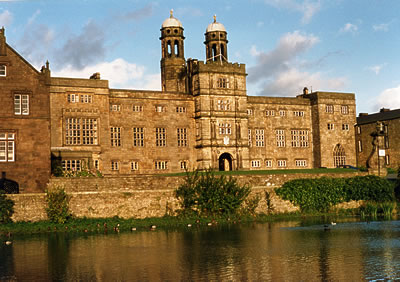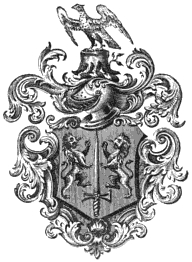|
Stonyhurst College
Stonyhurst College is a co-educational Catholic Church, Roman Catholic independent school, adhering to the Society of Jesus, Jesuit tradition, on the Stonyhurst, Stonyhurst Estate, Lancashire, England. It occupies a Grade I listed building. The school has been fully co-educational since 1999. A precursor institution of the college was founded in 1593 by Robert Persons, Father Robert Persons SJ at Saint-Omer, St Omer, at a time when penal laws prohibited Roman Catholic education in England. After moving to Bruges in 1762 and Liège in 1773, the college moved to Stonyhurst in 1794. It provides boarding and day education to approximately 450 boys and girls aged 13–18. On an adjacent site, its Preparatory school (UK), preparatory school, Stonyhurst Saint Mary's Hall, St Mary's Hall, provides education for boys and girls aged 3–13. The school combines an academic curriculum with extra-curricular pursuits. Roman Catholicism plays a central role in college life, with emphasis on ... [...More Info...] [...Related Items...] OR: [Wikipedia] [Google] [Baidu] |
List Of Old Stonyhursts
This article lists notable former pupils of Stonyhurst College in Lancashire, England, and its lineal antecedents at St Omer, Bruges and Liège. Former pupils are referred to in school contexts as O.S. (Old Stonyhurst). ''Inter alia'' the school counts among its most distinguished former pupils: three Saints, twelve ''Beati'', twenty-two martyrs, seven archbishops, and seven Victoria Cross winners. Alumni of the College at St Omer, Bruges, & Liège (1593–1794) Saints, beati and martyrs * St Philip Evans SJ, executed at Cardiff in 1679.Catholic.org entry Retrieved 9 July 2008. * St Thomas Garnet SJ, protomartyr of St Omer, one of the Forty Martyrs of England and Wales, executed at Tyburn in 1608. * [...More Info...] [...Related Items...] OR: [Wikipedia] [Google] [Baidu] |
Public School (United Kingdom)
In England and Wales (but not Scotland), a public school is a fee-charging financial endowment, endowed school originally for older boys. They are "public" in the sense of being open to pupils irrespective of locality, Christian denomination, denomination or paternal trade guild, trade or profession. In Scotland, a public school is synonymous with a state school in England and Wales, and fee-charging schools are referred to as private schools. Although the term "public school" has been in use since at least the 18th century, its usage was formalised by the Public Schools Act 1868, which put into law most recommendations of the 1864 Clarendon Report. Nine prestigious schools were investigated by Clarendon (including Merchant Taylors' School, Northwood, Merchant Taylors' School and St Paul's School, London) and seven subsequently reformed by the Act: Eton College, Eton, Shrewsbury School, Shrewsbury, Harrow School, Harrow, Winchester College, Winchester, Rugby School, Rugby, Wes ... [...More Info...] [...Related Items...] OR: [Wikipedia] [Google] [Baidu] |
Bruges
Bruges ( , nl, Brugge ) is the capital and largest City status in Belgium, city of the Provinces of Belgium, province of West Flanders in the Flemish Region of Belgium, in the northwest of the country, and the sixth-largest city of the country by population. The area of the whole city amounts to more than 13,840 hectares (138.4 km2; 53.44 sq miles), including 1,075 hectares off the coast, at Zeebrugge (from , meaning 'Bruges by the Sea'). The historic city centre is a prominent World Heritage Site of UNESCO. It is oval in shape and about 430 hectares in size. The city's total population is 117,073 (1 January 2008),Statistics Belgium; ''Population de droit par commune au 1 janvier 2008'' (excel-file) Population of all municipalities in Belgium, as of 1 ... [...More Info...] [...Related Items...] OR: [Wikipedia] [Google] [Baidu] |
Thomas Weld (of Lulworth)
Thomas Bartholomew Weld (1750–1810), known as Thomas Weld of Lulworth Castle, was a member of the English Catholic gentry, landowner, philanthropist and bibliophile. He was connected to many of the leading Catholic families of the land, such as the Bodenhams, Cliffords, Erringtons, Petres and Stourtons.''Burke's Genealogical and Heraldic History of the Landed Gentry'', Volume 2. H. Colburn, 1847. pp. 1545-6 view on lin/ref> He proved to be a great benefactor (law), benefactor of the Society of Jesus in England in their educational and pastoral endeavours, as timely donor of his Stonyhurst estate in 1794. He was also a benefactor to other Roman Catholic religious and clergy. He was a personal friend of King George III. His sister-in-law was Maria Fitzherbert. After the French Revolution he hosted refugee remnants of the French royal family at his castle. He was the builder, in 1786, of the first Roman Catholic place of worship in England after the Protestant reformation. Life ... [...More Info...] [...Related Items...] OR: [Wikipedia] [Google] [Baidu] |
Maria Howard, Duchess Of Norfolk
Maria (Mary) Winifreda Francisca Howard, Duchess of Norfolk (''née'' Shireburn or Sherburne; – 1754) was an English Catholic noblewoman, the last of the wealthy Shireburn family. She married twice, firstly to Thomas Howard, 8th Duke of Norfolk from whom she became estranged before his death and secondly to Peregrine Widdrington. She built a house in London on Arlington Street, which today is the clubhouse of the Royal Over-Seas League. Early life The only surviving child and heir of Sir Nicholas Shireburn, 1st and last Baronet of Stonyhurst and Catherine Charleton, Maria Shireburn was born into a prominent Catholic family in 1692 or 1693. Born in London, she grew up mainly at Stonyhurst Hall (now Stonyhurst College) in Lancashire. She was christened as Maria Windforda Francesca and always called Mary. Her older sister Isabel had died in 1688 and her brother Richard Francis accidentally killed himself in 1702 by eating poisonous berries. Her health was also bad and in 1698 ... [...More Info...] [...Related Items...] OR: [Wikipedia] [Google] [Baidu] |
Charles Carroll Of Carrollton
Charles Carroll (September 19, 1737 – November 14, 1832), known as Charles Carroll of Carrollton or Charles Carroll III, was an Irish-American politician, planter, and signatory of the Declaration of Independence. He was the only Catholic signatory and the last surviving signatory of the Declaration of Independence, dying 56 years after signing the document. Considered one of the Founding Fathers of the United States, Carroll was known contemporaneously as the "First Citizen" of the American Colonies, a consequence of signing articles in the ''Maryland Gazette'' with that pen name. He served as a delegate to the Continental Congress and Confederation Congress. Carroll later served as the first United States Senator for Maryland. Of all of the signers of the Declaration of Independence, Carroll was reputed to be the wealthiest and most formally educated of the group. A product of his 17-year Jesuit education in France, Carroll spoke five languages fluently. Born in Annapolis, M ... [...More Info...] [...Related Items...] OR: [Wikipedia] [Google] [Baidu] |
Frederick Weld
Sir Frederick Aloysius Weld (9 May 1823 – 20 July 1891), was a New Zealand politician and a governor of various British colonies. He was the sixth premier of New Zealand, and later served as Governor of Western Australia, Governor of Tasmania, and Governor of the Straits Settlements. Early life Weld was born near Bridport, Dorset, England, on 9 May 1823. His mother, Christina Maria Clifford, was the daughter of Baron Clifford of Chudleigh. Both of his parents were from old recusant Catholic families. His father, Humphrey Weld of Chideock, was a member of the Weld family. Humphrey's father Thomas Weld (of Lulworth) donated the land and endowed the Jesuit college at Stonyhurst. Weld's upbringing was strongly grounded in the Catholic faith. His early years were spent with his parents in France. Later, he received a good education, studying at Stonyhurst before attending a predecessor of the University of Fribourg in Switzerland, where he studied philosophy, chemistry, language ... [...More Info...] [...Related Items...] OR: [Wikipedia] [Google] [Baidu] |
Jose Gutierrez Guerra
Jose is the English transliteration of the Hebrew and Aramaic name ''Yose'', which is etymologically linked to ''Yosef'' or Joseph. The name was popular during the Mishnaic and Talmudic periods. * Jose ben Abin * Jose ben Akabya *Jose the Galilean *Jose ben Halafta *Jose ben Jochanan *Jose ben Joezer of Zeredah * Jose ben Saul Given name Male * Jose (actor), Indian actor * Jose C. Abriol (1918–2003), Filipino priest * Jose Advincula (born 1952), Filipino Catholic Archbishop * Jose Agerre (1889–1962), Spanish writer * Jose Vasquez Aguilar (1900–1980), Filipino educator * Jose Rene Almendras (born 1960), Filipino businessman * Jose T. Almonte (born 1931), Filipino military personnel * Jose Roberto Antonio (born 1977), Filipino developer * Jose Aquino II (born 1956), Filipino politician * Jose Argumedo (born 1988), Mexican professional boxer * Jose Aristimuño, American political strategist * Jose Miguel Arroyo (born 1945), Philippine lawyer * Jose D. Aspiras (1924–199 ... [...More Info...] [...Related Items...] OR: [Wikipedia] [Google] [Baidu] |
Eduardo López De Romaña
Eduardo López de Romaña y Alvizuri (19 March 1847 – 26 May 1912) served as the 32nd President of Peru from September 1899 to September 1903. A member of the landowning elite, he was the first engineer to become President of the Republic, and one of several Presidents from the era of the so-called Aristocratic Republic. Early years López de Romaña was born in Arequipa, the son of Juan Manuel López de Romaña y Fernández Pascua and María Josefa Alvizuri y Bustamante. His father was a wealthy landowner of Spanish ancestry owner of large ''haciendas'' and ''fincas'' in the Southern Peru. He was educated at the San Jerónimo Seminary, Arequipa, and Stonyhurst College, Lancashire. Romaña received his B.A. from King's College London in 1868 and was appointed a member of the Institute of Civil Engineers of London in 1872. He went to India and worked in the construction of the Ravi Bridge for the Punjab Northern State Railway and then to Brazil where he was employed ... [...More Info...] [...Related Items...] OR: [Wikipedia] [Google] [Baidu] |
Victoria Cross
The Victoria Cross (VC) is the highest and most prestigious award of the British honours system. It is awarded for valour "in the presence of the enemy" to members of the British Armed Forces and may be awarded posthumously. It was previously awarded by countries of the Commonwealth of Nations, most of which have established their own honours systems and no longer recommend British honours. It may be awarded to a person of any military rank in any service and to civilians under military command. No civilian has received the award since 1879. Since the first awards were presented by Queen Victoria in 1857, two-thirds of all awards have been personally presented by the British monarch. The investitures are usually held at Buckingham Palace. The VC was introduced on 29 January 1856 by Queen Victoria to honour acts of valour during the Crimean War. Since then, the medal has been awarded 1,358 times to 1,355 individual recipients. Only 15 medals, of which 11 to members of the Britis ... [...More Info...] [...Related Items...] OR: [Wikipedia] [Google] [Baidu] |
Beatification
Beatification (from Latin ''beatus'', "blessed" and ''facere'', "to make”) is a recognition accorded by the Catholic Church of a deceased person's entrance into Heaven and capacity to intercede on behalf of individuals who pray in their name. ''Beati'' is the plural form, referring to those who have undergone the process of beatification; they possess the title of "Blessed" (abbreviation "Bl.") before their names and are often referred to in English as "a Blessed" or, plurally, "Blesseds". History Local bishops had the power of beatifying until 1634, when Pope Urban VIII, in the apostolic constitution ''Cœlestis Jerusalem'' of 6 July, reserved the power of beatifying to the Holy See. Since the reforms of 1983, as a rule, one miracle must be confirmed to have taken place through the intercession of the person to be beatified. Miracles are almost always unexplainable medical healings, and are scientifically investigated by commissions comprising physicians and theologia ... [...More Info...] [...Related Items...] OR: [Wikipedia] [Google] [Baidu] |



.jpg)



